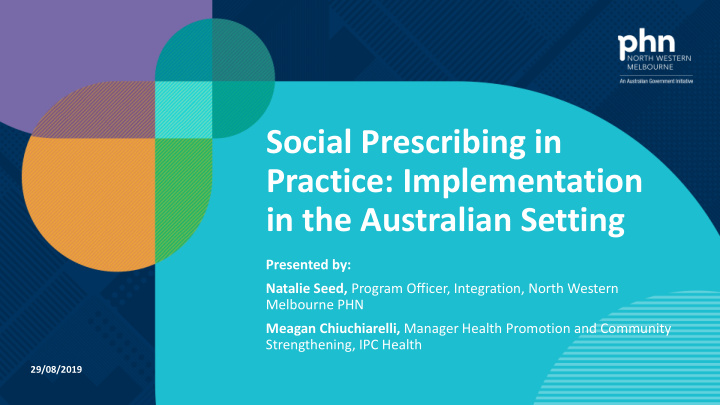



Social Prescribing in Practice: Implementation in the Australian Setting Presented by: Natalie Seed, Program Officer, Integration, North Western Melbourne PHN Meagan Chiuchiarelli, Manager Health Promotion and Community Strengthening, IPC Health 29/08/2019
Introduction The project is a partnership of the Brimbank Collaboration – Brimbank City Council, Australian Health Policy Collaboration at Victoria University, IPC Health and North Western Melbourne Primary Health Network (NWPHN). The project is a small scale, three stage process of research, testing and implementation at IPC Health Deer Park and within the Brimbank community. Demonstration Phase : July 2019 – June 2020 29/08/2019 Social Prescribing in Practice: Implementation in the Australian Setting 2
Why Brimbank? In the City of Brimbank the following rates of health risks are identified : • Brimbank is in the third lowest index of socio-economic disadvantage in Victoria (2016) particularly in the corridor of Sunshine North, St Albans, Kings Park • The region has the second lowest participation in health enhancing physical activity • 1 in 5 people have poor to fair self -reported health status (38% above Australian rate) • Hospitalization rates for adults with chronic co-morbidity in the region are high • 10.2% of adults have mental health conditions, compared to 7.9% average in Melbourne • 1 in 8 men in the region have high or very high psychological stress (37% above the Australian rate) • The region has the sixth highest rate of diabetes in greater Melbourne (63% above Australian average) Brimbank Atlas of Health and Education. 2014. Australian Health Policy Collaboration, VU 29/08/2019 Social Prescribing in Practice: Implementation in the Australian Setting 3
Social Prescribing Social Prescribing links clients and community organisations, creating a pathway to deliver health and well-being interventions using life prescriptions to complement traditional forms of medical and health care. Referrals are made to the Social Prescribing Community Link Worker who coordinates a plan and schedules access to local sources of support. These may include physical activity or social groups, peer support groups, parenting classes or legal or financial counselling. Community Link Workers also engage community partners to support the program and build membership. 29/08/2019 Social Prescribing in Practice: Implementation in the Australian Setting 4
Social Prescribing aims to: Empower individuals to develop their capacity to manage and improve their health and wellbeing, and social welfare Improve social connectedness Reduce demand for health professionals to address non-medical issues 29/08/2019 Social Prescribing in Practice: Implementation in the Australian Setting 5
29/08/2019 Social Prescribing in Practice: Implementation in the Australian Setting 6
Project Update 38 referrals 13 GP Clinic 18 Allied health and Counselling 2 people declined 1 External referral (not suitable) 5 Self referrals 32 interviews & plans completed Most clients linked to activity and/or sign posted to another service – some internal • mental health issues Referral • carer burden and change in carer circumstances • volunteering/employment and skill seeking opportunities Reasons • financial hardship • socially isolated / living alone with few supports 29/08/2019 Social Prescribing in Practice: Implementation in the Australian Setting 7
Case Study Penny is an 82-year-old woman of Greek heritage, and primary carer of her husband until he died earlier this year. Her family are concerned she is losing confidence and maybe isolating herself. Although reluctant, Penny expressed a willingness to attend an activity group, primary interest being craft work, one that has a purpose. The Community Linkworker supports Penny to join a knitting group that sells their craft to raise money for IPC Health. She settles in well and continues to attend. Penny has increasing self-confidence and a drive to be present for her family and grandchildren. The Community Linkworker supports Penny to access a walking group at a community center near where she lives. Penny is now actively walking every week and has made new friends with whom she attends various activities and events. The clients’ identity has been protected. This is not a image of the client. 29/08/2019 Social Prescribing in Practice: Implementation in the Australian Setting 8
Lessons Learned GP and medical team engagement • Early engagement of the whole team • Support from the Practice Manger and Nurse • Prompt responsiveness to any enquiry (co-location) • Regular feedback to the GPs who have referred; talk to client outcomes Who is suitable for referral? • Challenging to know because it is a universal services (i.e. no eligibility criteria) • Social Prescribing is not a replacement for other health or welfare referral systems • Clients’ capacity and agency must be a consideration 29/08/2019 Social Prescribing in Practice: Implementation in the Australian Setting 9
What’s next? • Social Prescribing has just recently been opened for external referrals. • The Link worker will continue supporting new clients, and will follow up with existing clients. • Expanding the network of collaborative Health, Community and volunteer services. • The Social Prescribing project team and reference group will continue to build and refine a suite of tools , processes and resources for the service. E.g. Asset map. • Evaluation: Client experience, feedback and short term outcomes • Feasibility Report and business case 29/08/2019 Social Prescribing in Practice: Implementation in the Australian Setting 10
Further Information Dinna Tayao Social Prescribing Project Manager T: 03 9219 7122 E: Dinna.Tayao@ipchealth.com.au Catherine Cotching Natalie Seed Social Prescribing Community Linkworker Program Officer, Integration T: 03 9219 7146 T: 03 9347 1188 E: Catherine.Cotching@ipchealth.com.au E: Natalie.seed@nwmphn.org.au 29/08/2019 Social Prescribing in Practice: Implementation in the Australian Setting 11
Recommend
More recommend